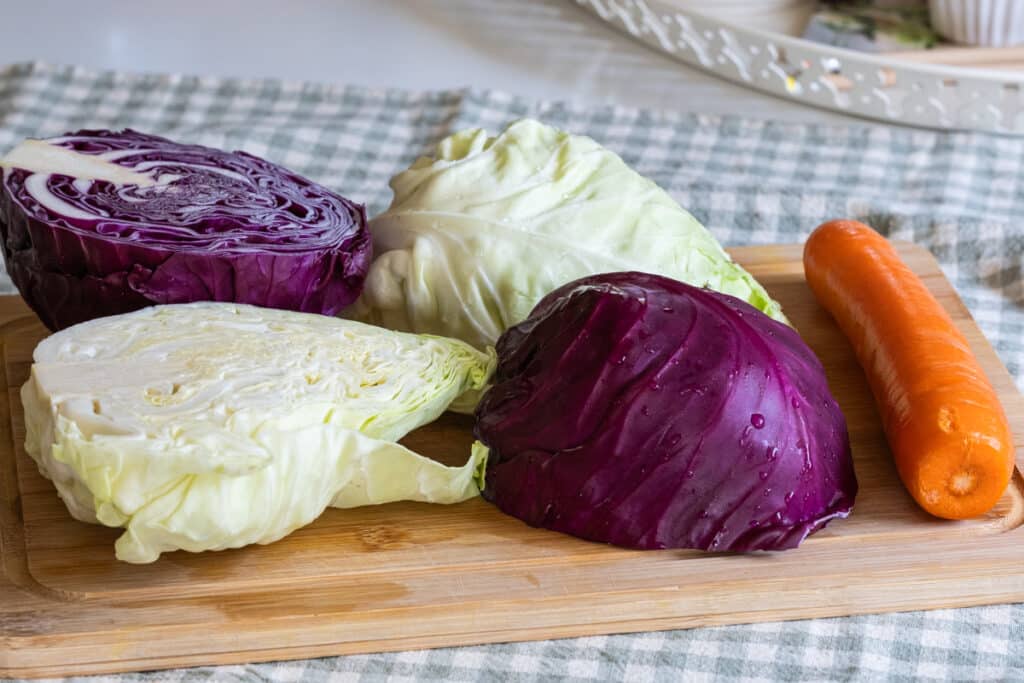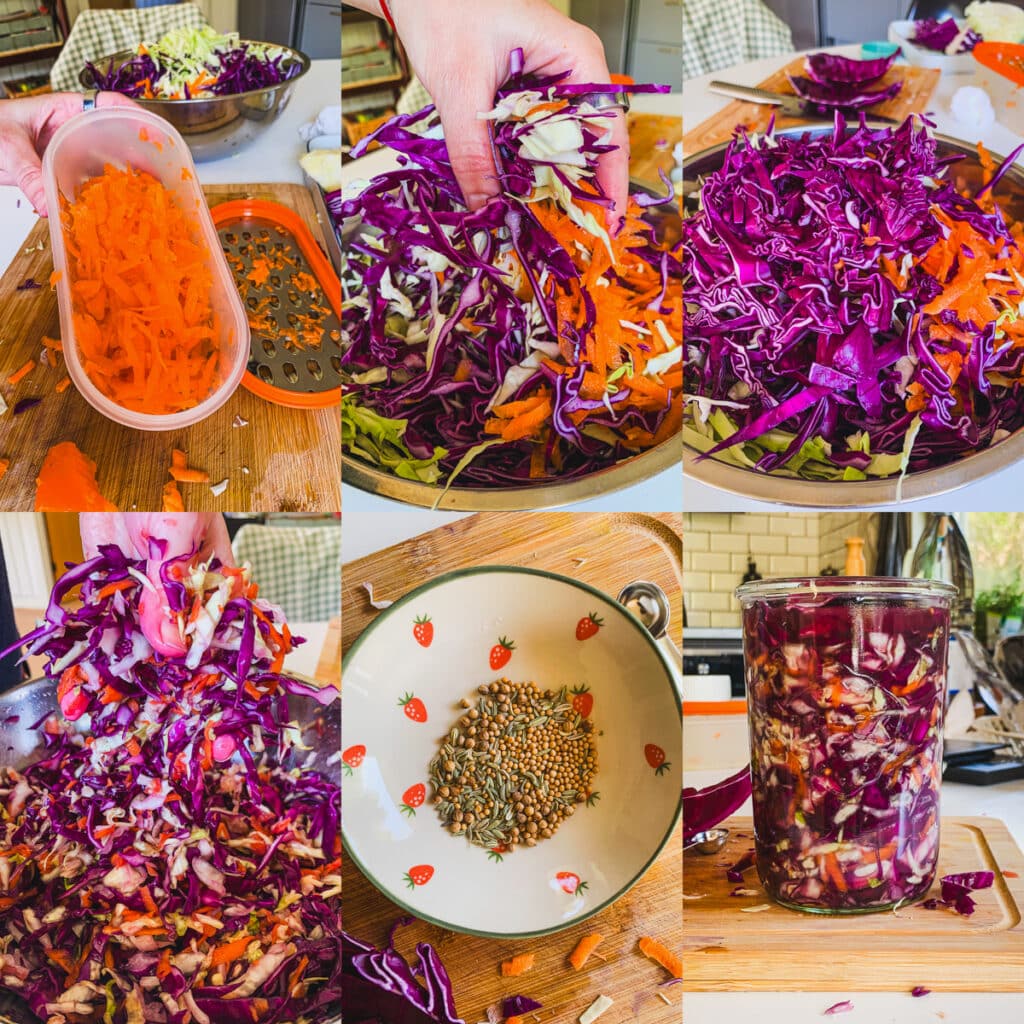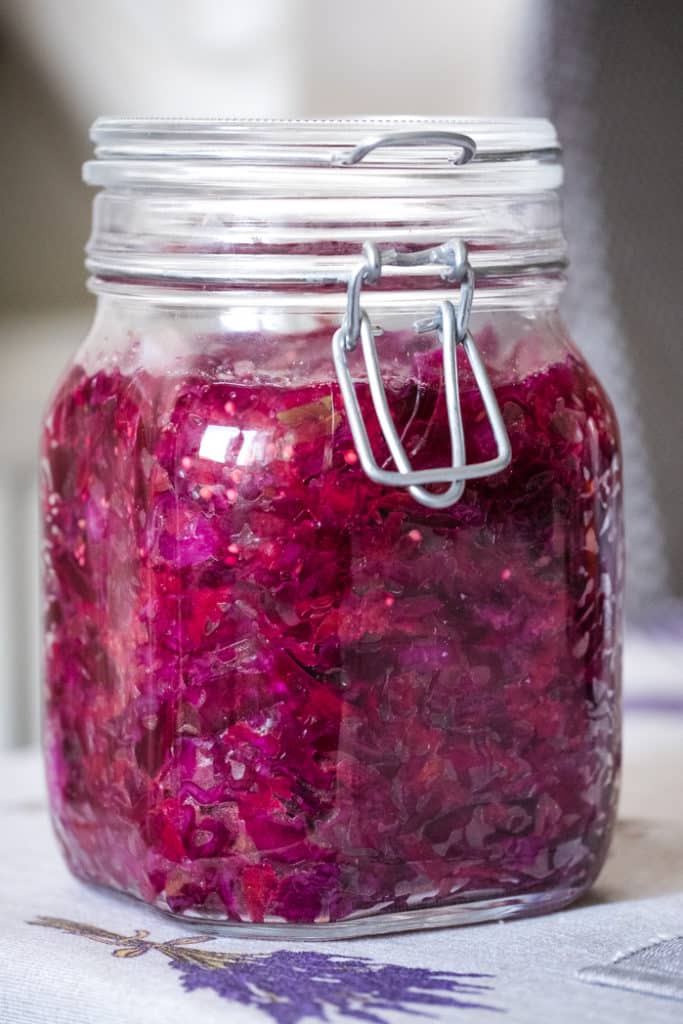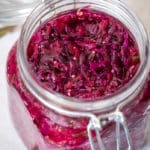Fermentation is one of the oldest and safest ways of preserving food known to humanity. And while it might seem a bit intimidating at first, it’s actually quite simple to begin.
This red cabbage sauerkraut is a great entry point into the world of fermentation—low-cost, low-risk, and packed with gut-friendly benefits. It’s also much more affordable (and often tastier) than store-bought options, which can be hard to find in their raw, unpasteurized form.
Can You Make Sauerkraut with Red Cabbage?
Yes! Red cabbage works beautifully for sauerkraut. You can also use white cabbage, or a mix of red and white, depending on what you have on hand or the flavor and color you prefer. If you’re new to fermentation, this recipe is a great place to start. Follow the simple method below and you’ll be rewarded with a vibrant, tangy ferment rich in probiotics and flavor.
What Happens During Fermentation?
Through fermentation, vegetables are transformed nutritionally and functionally. Naturally occurring bacteria break down the sugars and starches in the cabbage, which makes it easier to digest, improves mineral bioavailability, reduces anti-nutrients, and produces beneficial compounds that support gut and immune health.
To preserve the live bacteria, your sauerkraut must remain raw. If you’re buying sauerkraut for health benefits, look for unpasteurized versions in the refrigerated section, clearly labeled as RAW.
No Water Needed: A Natural Fermentation Method
What makes this method especially approachable is that no water is required. The cabbage and carrots release their own juices when salted and massaged, creating a natural brine. This is important because chlorinated tap water (commonly used in fermentation with added brine) can inhibit the growth of beneficial bacteria. If you do ferment with water in other recipes, be sure to use filtered or spring water.
Ingredients and Tools
For a quart-sized mason jar (about 36 oz / 1 liter), you’ll need:
- 1 small to medium head of red cabbage, or a mix of red and white cabbage
- 1 large or 2 medium carrots, grated
- 2 teaspoons non-iodized salt, such as sea salt or Himalayan pink salt (about 1.5% of the total vegetable weight)
- Optional spices: mustard seeds, fennel seeds, peppercorns, coriander seeds, bay leaves, cloves, allspice, juniper berries, caraway seeds
Basic tools include a sharp knife, grater or food processor, a large mixing bowl, a clean cutting board, and a glass jar with a lid.

How to Make It
Start by thoroughly cleaning your hands, utensils, and work surfaces. Cleanliness is essential to support the right kind of microbial growth.
Wash the cabbage and carrots well. Finely shred the cabbage and grate the carrots. In a large bowl, combine the vegetables with the salt. Begin massaging the mixture with your hands. After several minutes, the vegetables will soften and start releasing liquid. This brine is what will protect and preserve the ferment.
If you’re using spices, you can add them directly to the bowl or place them at the bottom of the jar. This helps infuse the sauerkraut with subtle flavor, though spices are entirely optional.
Transfer the mixture into your jar a little at a time, packing it down firmly with each addition. Press the vegetables down well to eliminate any air pockets. Once all the vegetables are in, pour any remaining liquid from the bowl over the top. The goal is to keep everything submerged under the brine.
Cover the jar with the lid, without using the rubber band for sealing. You don’t want to seal it airtight, as gases produced during fermentation need a way to escape.

Fermentation Time and Storage
Leave the jar at room temperature, ideally out of direct sunlight. I recommend using a bowl to catch the overflow resulting from fermentation. Once or twice a day, open the jar and press down the vegetables with a clean spoon to keep everything submerged.
Fermentation time depends on the temperature of your kitchen and your personal taste. It usually takes between 4 and 14 days. In a warmer environment, it may be ready in as little as 4–5 days. When the flavor reaches your preferred level of tanginess, seal the jar and store it in the refrigerator or a cool pantry. It will continue to develop slowly in cold storage and keep for several months.
How to Serve Red Cabbage Sauerkraut
Homemade sauerkraut is a delicious and versatile addition to your meals. Try it with eggs, as a side to meat or chicken, or mixed into cooked or raw vegetable dishes. It pairs especially well with my Lectin-Light Pork Paprikash and with any stew-like meal where a pop of acidity adds balance.

More Fermented Vegetables
If you’re feeling inspired to explore fermentation, be sure to check out my article and recipe: How to Make Fermented Mixed Vegetables.
And you won’t want to miss out on these incredible fermented dill pickles. They are the perfect gut-healthy treat for summer.
*This post contains affiliated links, which means I get a small commission if you choose to purchase something via one of my links, at no extra cost to you.
Print
Red Cabbage Sauerkraut
- Prep Time: 20 minutes
- Total Time: 20 minutes
- Yield: 36 oz
Description
Fermentation is one of the oldest and safest methods of preserving food known to humanity. While it might seem intimidating at first, it’s surprisingly simple to get started. This red cabbage sauerkraut is a great way to explore the basics of fermentation and create a gut-friendly food you can enjoy daily—as a condiment, side dish, or a flavorful boost to any meal.
Ingredients
Jar: 1 quart / 36 oz / 1 L glass jar with lid
About 2 lbs (800–900g) organic vegetables — red cabbage (white cabbage works too, or a mix), plus one large carrot
12.5g non-iodized salt (about 1.5% of the total vegetable weight)
Optional spices: ¼ teaspoon each of coriander seeds, fennel seeds, and mustard seeds
Instructions
- Thoroughly wash the jar, lid, and your working surface. Rinse and pat dry the vegetables.
- Finely shred the cabbage (one medium or two halves) and place it in a large mixing bowl. Set aside a couple of whole outer cabbage leaves to use later. Grate one large carrot and add it to the bowl.
- Sprinkle the salt (and optional spices) over the vegetables, then massage everything with clean hands for 5–10 minutes, until the vegetables soften, release their juices, and reduce in volume.
- Transfer the mixture and the liquid into your jar, pressing down firmly to eliminate air pockets and make sure the vegetables are fully submerged in their own brine. Fold and place the reserved whole cabbage leaves on top, pressing down again. Secure the lid loosely (without the silicone seal) to allow gases to escape during fermentation.
- Place the jar in a shallow bowl to catch any overflow, and leave it at room temperature, away from direct sunlight. Open the lid once a day and press down gently with a clean spoon to keep everything submerged.
- Fermentation usually takes 4–7 days, depending on the temperature of your kitchen. It could even be faster is it’s very hot. Start tasting after day 4. Once the kraut reaches your preferred level of sourness, remove the top leaves, seal the jar fully, and refrigerate.
- Enjoy a small amount daily as a gut-friendly condiment or side dish.


No Comments